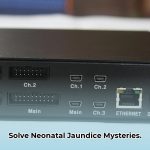Newborn jaundice is common, needing careful monitoring to prevent complications. Healthcare providers choose between transcutaneous bilirubin (TcB) measurements and total serum bilirubin (TSB) blood tests to check bilirubin levels. For a deeper dive into TcB vs. TSB, see this helpful resource: TcB vs. Serum Bilirubin. This article explores the advantages, disadvantages, and appropriate use cases for both methods, aiming for optimal accuracy and painless care for neonates. We will cover everything from initial screening to monitoring treatment, ensuring the well-being of newborns.
Neonatal Jaundice Assessment: TcB Measurement vs. Blood Test Considerations
Neonatal jaundice, characterized by a yellowish tinge in a baby’s skin and eyes, is a frequent occurrence. Monitoring bilirubin levels is vital to prevent potential harm. Two primary methods exist: transcutaneous bilirubin (TcB) measurement for a quick estimate and total serum bilirubin (TSB) blood tests for precise measurement. The optimal choice depends on the clinical scenario and individual patient factors.
Understanding Transcutaneous Bilirubin (TcB) Measurement
TcB measurement is a non-invasive method to estimate bilirubin levels. A handheld device gently touches the baby’s skin, usually on the forehead or sternum, providing a quick assessment. It minimizes discomfort and avoids the risk of bleeding or infection associated with blood draws, making it a useful first-line screening tool. Notably, TcB is advantageous for frequent monitoring during phototherapy.
Total Serum Bilirubin (TSB) Blood Tests: The Precision Standard
The TSB blood test remains the gold standard for bilirubin measurement, offering a detailed and precise analysis of bilirubin levels in the baby’s blood. A small blood sample is taken, typically from a heel prick, and sent to a laboratory for analysis. While more accurate than TcB, it requires a needle prick, causing slight discomfort and a minimal risk of infection.
Initial Assessment and Screening: TcB as a First-Line Tool
TcB measurement excels in several clinical scenarios:
- Initial Screening: As a first step for babies showing signs of jaundice, the TcB measurement quickly assesses the need for further testing, reducing unnecessary blood draws. This is particularly useful in outpatient settings and for routine monitoring in the nursery.
- Treatment Monitoring: Regular TcB measurements can track the effectiveness of phototherapy treatment, potentially diminishing the need for frequent blood tests. This allows for timely adjustments to the treatment plan.
- Reducing Invasive Procedures: TcB measurements minimize the number of painful needle sticks, crucial for the baby’s comfort and reducing risks associated with multiple blood draws. Minimizing invasive procedures aligns with best practices in neonatal care.
- Cost-Effectiveness and Accessibility: TcB offers a more affordable and convenient option, especially where blood tests are costly or difficult to access. This makes jaundice monitoring more accessible in various healthcare settings.
When Precision Matters Most: The Necessity of Blood Tests (TSB)
Despite its benefits, TcB has limitations, requiring blood tests in certain situations:
- High-Risk Infants: Premature babies, those with complications (such as Rh incompatibility or G6PD deficiency), or displaying severe jaundice symptoms (such as lethargy or poor feeding) necessitate the accuracy of a blood test. The risk of inaccurate TcB readings is higher in such cases, and precise bilirubin values are critical for management.
- Unclear TcB Results: A blood test confirms bilirubin levels when TcB readings are ambiguous, unexpectedly high, or inconsistent with the clinical picture, ensuring appropriate treatment. Definitive diagnosis is critical in these instances.
- Critical Treatment Decisions: When making decisions about interventions like exchange transfusions, precise bilirubin measurements from a blood test are essential. Accuracy is paramount in these high-stakes situations.
- Establishing Baselines: Healthcare providers generally prefer a baseline TSB to obtain an accurate starting point for monitoring jaundice effectively. This helps track changes over time, especially in infants with risk factors.
Interpreting TcB Results: Factors Influencing Accuracy and Reliability
Several factors influence TcB accuracy and must be considered when interpreting results:
- Skin Tone: TcB measurements might underestimate bilirubin levels in babies with darker skin tones and slightly overestimate levels in those with lighter skin tones. This necessitates careful interpretation and consideration of correction factors where available.
- Gestational Age: Premature infants often yield less reliable TcB readings due to differences in skin characteristics that affect scan accuracy. Special attention should be paid to these readings and confirmed with TSB measurements when necessary.
- Device Calibration: Regular calibration of the TcB device is crucial to ensure accurate measurements and consistent performance. Consistent calibration is essential and should follow manufacturer guidelines.
- Ambient Lighting Conditions: The lighting during the measurement can affect results, emphasizing the need for consistent lighting conditions during measurement. Avoid direct sunlight or fluorescent lights that could skew results.
- Measurement Site: Measurements should be taken on clean, dry skin, free of lotions or creams. The most common sites are the forehead and sternum.
Holistic Assessment: Integrating Clinical Context and Test Results
Healthcare providers consider the baby’s overall health, gestational age, family history, feeding patterns, and other relevant factors alongside the TcB or TSB results to develop a comprehensive understanding of the baby’s condition. This holistic approach ensures the best possible care. According to [Dr. Maria Rodriguez, Chief of Neonatology at University Hospital], a comprehensive understanding optimizes patient outcomes and prevents unnecessary interventions.
The Future of Jaundice Assessment: Enhancing Technology and Accuracy
Ongoing research focuses on improving TcB technology, developing advanced algorithms and sensors for more precise and reliable measurements, particularly for babies with darker skin tones. Researchers are also exploring the use of spectral reflectance techniques to improve accuracy across diverse populations. These advancements promise to further enhance the accuracy and utility of TcB measurements.
TcB vs. TSB: Evaluating the Trade-Offs in Neonatal Jaundice Management
Choosing between a TcB measurement and a blood test requires careful consideration of the individual baby’s needs, risk factors, and clinical presentation. Open communication between parents and medical professionals is vital to make informed decisions about the baby’s care. Continuous research endeavors enhance the efficacy of jaundice management, leading to improved outcomes for newborns.
Key Takeaways:
- TcB offers a non-invasive alternative to blood tests, reducing the need for painful heel sticks.
- TcB accuracy is influenced by several factors, including skin tone, gestational age, and device calibration.
- Clinical judgment and careful interpretation of results, in conjunction with a thorough clinical assessment, are crucial for effective jaundice management.
How to Improve Transcutaneous Bilirubinometry Accuracy in Darker Skin Tones
Transcutaneous bilirubin (TcB) testing provides a less invasive method than blood tests (serum bilirubin, or SB) for assessing neonatal jaundice. While TcB reduces the need for blood draws, its accuracy is affected by skin pigmentation, particularly in infants with darker skin tones. Addressing this disparity is crucial. At higher bilirubin levels (>15 mg/dL), understanding the limitations of TcB is crucial for clinical decisions along with standardized protocols and improved devices.
Understanding TcB: A Non-Invasive Screening Tool
TcB utilizes a non-invasive device to measure bilirubin levels through the skin. It’s a quick, painless procedure, making it favorable for babies and parents. Melanin, responsible for skin color, can interfere with the accuracy of TcB readings, particularly in darker skin, highlighting the need for improved technology and protocols. Is it possible to make TcB more reliable for all infants, regardless of skin tone?
TcB versus Blood Tests: Clinical Decision-Making
When should TcB be used, and when is a blood test essential? Ideally, TcB should be used as much as possible to minimize needle pricks. However, blood tests are crucial when bilirubin levels are high (above 15 mg/dL or values approaching exchange transfusion thresholds), when the TcB reading is questionable, or when managing high-risk infants. TcB serves as a screening tool, while blood tests confirm results, particularly in high-risk neonates. What are the specific thresholds for each test in different clinical scenarios?
Strategies for Enhancing TcB Reliability: Minimizing Discrepancies
Several strategies can enhance TcB reliability, especially when used in infants with darker skin tones:
- Correct Device Utilization: Proper placement of the sensor, ensuring good contact with the skin, and strict adherence to manufacturer instructions are crucial for obtaining reliable results. Training plays a key role. Is training standardized across healthcare facilities and regularly updated?
- Device Calibration: Regular calibration of the TcB device ensures accurate measurements. Calibration should align with manufacturer guidelines and be a routine part of device maintenance. Is calibration frequency sufficient, and are calibration procedures optimized for diverse skin tones?
- Optimal Skin Condition: The skin’s condition can affect TcB readings. Jaundiced skin that’s dry, edematous, or has other issues can lead to inaccurate readings. Ensuring the skin is clean and dry before measurement is essential. What are the detailed protocols for skin preparation?
- Addressing Skin Tone Variations: Research focuses on developing algorithms and correction factors that account for variations in skin pigmentation to improve accuracy across all skin tones. Some newer devices incorporate these algorithms. Are there validated and readily available correction algorithms for various TcB devices?
- Multiple Measurements: Taking multiple TcB measurements and averaging the results may improve accuracy.
Considerations
Even with improvements, TcB is not a perfect replacement for blood tests. Following your healthcare professional’s guidance on when and how to use these tests is always best. What are the specific clinical indicators that warrant a blood test,
- Vertical Axis Wind Turbine Design: Improving Efficiency and Overcoming Limits - October 29, 2025
- Wind Turbine to Power Home: Nacelle Design Improvements Advance - October 26, 2025
- Wind Turbine Blade Length: How Long Is Too Long? - October 24, 2025















